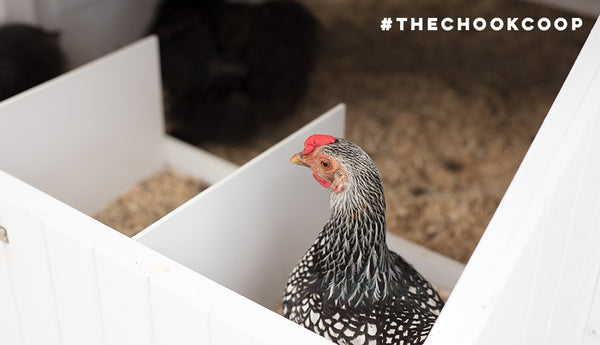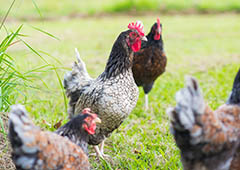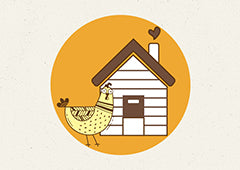The humble asparagus is one of the most striking, distinctive and memorable vegetables when it comes to garden grown produce. Tall, lean and green, this universally popular plant is renowned for its exceptional health benefits, unique flavour and some other surprising side effects. Perfect for families and flocks of all sizes, there is always reason to keep a neat bouquet of asparagus tucked away in your crisper. Take a moment now to find out the top 7 reasons you and your chickens need more asparagus in your life.
1. Asparagus will improve the health of your body and mind.
In Ancient Greece asparagus was considered to be a cleansing vegetable with healing properties and in many respects they were absolutely right. Asparagus is a dense source of vitamin C, potassium, sodium, iron and antioxidants, all of which help keep your body in full working order. Additionally, regular consumption can help boost your mood due to its strong B vitamins and folate content, which increases vitality and supports healthy serotonin and dopamine function. What does all of this mean in an egg shell? Including asparagus as a regular part of your diet can help improve the overall health of your body and mind, pure and simple.
2. There are three fantastic varieties of asparagus you can become obsessed with.
Some people might be surprised to discover that there are actually three relatively popular varieties of asparagus found in Australia. Though all types of asparagus have many of the same health benefits, it’s interesting to compare the subtleties that makes each variety unique.
Green asparagus: Perhaps the most popular variety in Australia, green asparagus is loved for its firm dark green and glossy spears that have a crisp and tender texture when cooked. In season from early September, green asparagus can normally be enjoyed until the end of March.

White asparagus: Recognised as a delicacy in Europe, white asparagus gets its colour from being grown in enclosed greenhouses with minimal exposure to sunlight. White asparagus tends to have a limited supply due to the increased production costs. Typically white asparagus costs twice as much as regular green asparagus.
Purple asparagus: Purple asparagus is one of the rarest varieties and is only available between mid-October to mid-December in Australia. More tender in texture, purple asparagus is rich in antioxidants but has less fibre than white and green asparagus and can be eaten from root to tip.
Whatever variety of asparagus you choose to grow in your garden or put in your trolley you’ll be able to rely on chickens to clean up your scraps.
3. Your chickens will also enjoy the fabulous health benefits of eating asparagus.
Asparagus is good for chickens for many of the same reasons it is beneficial for humans. Whether you feed your chickens leftover scraps or freshly harvested asparagus spears your flock will savour every morsel. There have been some accounts of asparagus changing the flavour of a chicken’s eggs. Though feeding your chicken asparagus poses no threat to their health, it is probably wise to moderate how much asparagus they eat. If you notice any unfavourable change in the taste of your flock’s eggs, simply feed them fewer asparagus scraps.
If you’re interested in boosting your flock’s immunity in other natural ways, why not check out our Hen Health Kit, which includes Chicken Lady and Lad favourites like apple cider vinegar and diatomaceous earth.
4. Get ready for an avalanche of asparaguses when they are in season.
Successfully growing your own backyard asparagus can take several years before you can reap the benefits, however once the plants mature be prepared to harvest oodles of these nutritious little green spears. The asparagus plant’s root structure tends to grow from 1.5 to 2 M deep in ground, with a small head popping out above the soil known as the crown. Edible spears grow rapidly out of the crown when in season, which can be harvested by simply cutting them free, leaving the crown intact. Though it can take several years before the asparagus plant produces spears at its peak, once it has matured, they can grow at the rate of 2 cm every hour and will need to be harvested on a daily basis. Each asparagus plant can produce spears for up to 20 years, so long as the plant is given plenty of tender loving and care.
5. Keeping asparagus fresher for longer is easy when you know what you’re doing.
Asparagus spears can be a little vulnerable when cut free from the crown of the plant. Some gardening gurus compare keeping harvested asparagus to delicate fresh cut flowers. Though asparaguses will always have a shorter shelf life compared to other garden grown vegetables, like garlic and pumpkin, there are still some easy ways you can extend their life expectancy. By simply creating a cool and humid environment you will be able to drastically increase the longevity of fresh harvest asparagus. Here are two simple tips for keeping your asparagus fresh, crisp and delicious…
I. Simply wrap the roots of your asparagus in a damp towel, place in a plastic bag and store in the crisper of your fridge.
II. Soak the roots of your fresh cut asparagus in a container with just 1 cm of water, cover and store in the fridge.
Before you plant your crops make sure you consider the rate in which asparagus grow when they are in season and the space required to keep your produce fresh. Though it’s easy to give away fresh, excess garden produce, it would be a shame for any of these little veggie wonders to go to waste.
6. There are so many delectable culinary creations that feature asparagus.
Whether it’s breakfast, lunch or dinner you can enjoy asparagus at any time of day. Traditionally, asparagus pairs well with farm fresh perfectly poached eggs. For lunch or dinner, asparagus pairs perfectly with fresh salmon, steak, mushrooms or alongside a wide array of nuts. Whether it is mixed through a pasta or stir fry or simply grilled and served as a side, asparagus is an easy way to kick every meal up a notch.
7. Asparagus is an ancient aphrodisiac.
On first glance it might seem ludicrous to believe that these short, cylindrical and green vegetables have been considered a natural aphrodisiac for thousands of years. In large part this can be attributed to the overall health benefits that asparagus offers. Healthy and happy people tend to have more energy at the end of the day, once the sun goes down. So, if you’re looking to spice up your Wednesday night routine, maybe you should consider adding a side of asparagus to your dinner plate more regularly.
No matter the reason, asparagus is a perfect addition to your garden, dinner plate and your chickens appreciate a little variety in their diet. One of the best ways to boost the quality of your garden soil is by adding chicken manure enriched compost to your garden beds before planting. Chicken tractors like the Taj Mahal and Cluck House are the easiest way to safely spread the benefits of your flocks power poos all over your garden.
To find out more chicken friendly vegetables that you can plant in your garden, simply click here.
From veggies to safe housing to weather proofing, as chicken keepers, we want to do an eggcellent job when caring for our feathered friends. Many chicken keepers struggle to handle chicken health or behaviour issues, especially in the first few years of having a flock.
This is why I recommend Chickenpedia to all my readers. They have comprehensive online courses on everything you didn’t know you need to know and then some more! From healthcare to raising baby chicks to feeding and behavior, you’ll find beginner-friendly courses that’ll give you the knowledge and confidence to successfully look after your chickens.
As a member, you will get access to ALL their fantastic courses. No need to wing it, become the ultimate chicken eggspert! Check out Chickenpedia today!



















